The Qualcomm Snapdragon 820 Performance Preview: Meet Kryo
by Ryan Smith & Andrei Frumusanu on December 10, 2015 11:00 AM EST- Posted in
- SoCs
- Snapdragon
- Qualcomm
- Snapdragon 820
CPU Performance, Cont
Having taken a look at Snapdragon 820 and the Kryo CPU from an architectural perspective, let’s look at our higher level benchmarks. We’ll start as always with the web benchmarks.

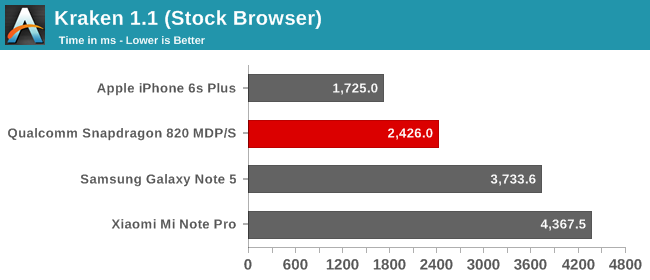
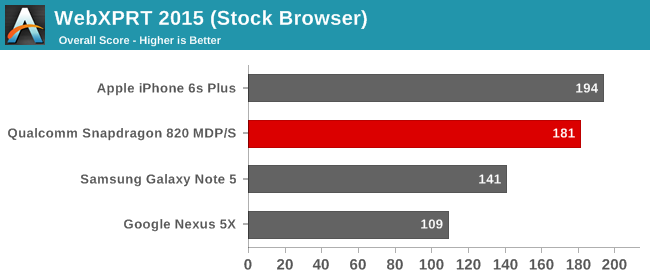
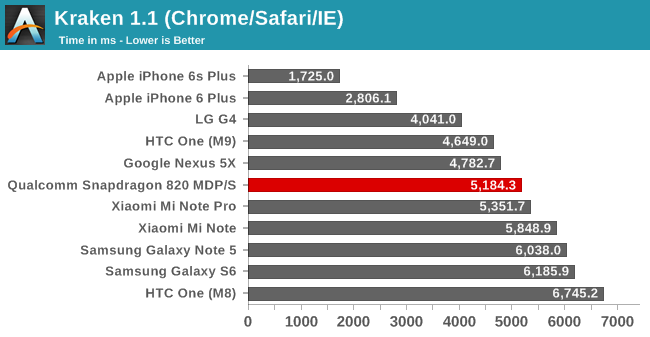

There are two things we can immediately take away from these results. The first is that currently Google Chrome is incredibly unoptimized for Kryo, and this is something Qualcomm was also quick to mention. We won’t wax on about this as there’s nothing to say we haven’t said before, but Chrome could certainly stand to implement optimized JS engines sooner.
Otherwise if we look at Qualcomm’s native browser, things are greatly improved. Relative to both the Exynos 7420 (A57) powered Note 5 and the Snapdragon 810 (A57) powered Mi Note Pro, the MDP/S shows a significant lead. In fact it pretty much blows past those devices in Kraken. However while it easily takes the top spot for an Android device, even with Qualcomm’s native browser the 820 isn’t going to be able to catch up to the iPhone 6s Plus and its A9 SoC.

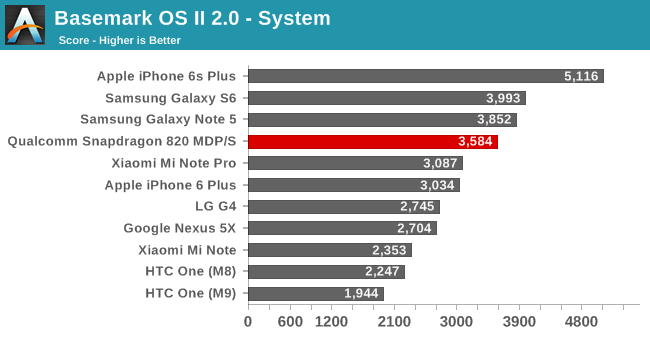
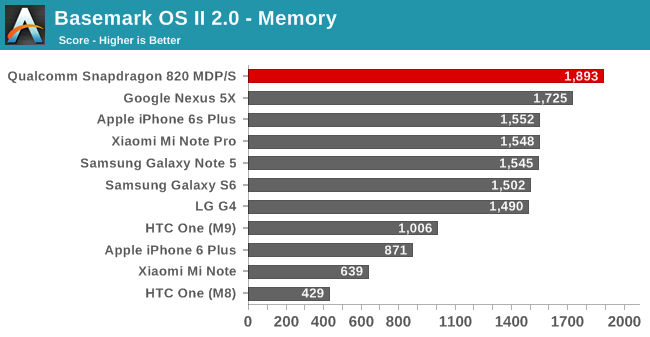
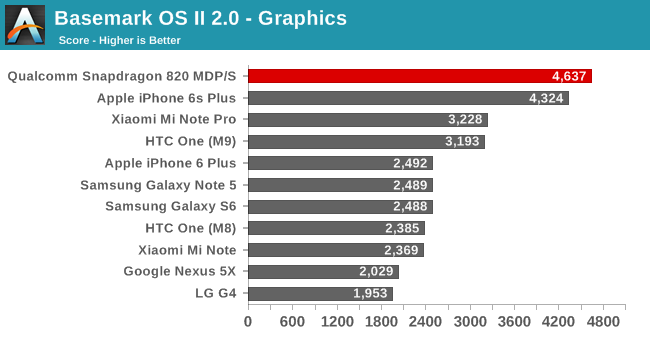
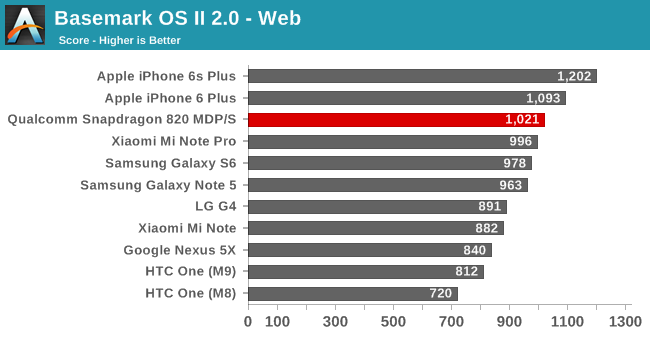
Basemark OS II 2.0 on the other hand is less consistent. The overall score again pegs the MDP/S as the best Android device, and by over 20%. However for reasons yet to be determined, the system score is still below the latest Samsung devices. Instead where the 820 shows a clear lead is with the storage (memory) score and the graphics score. In some cases it’s even beating the iPhone 6s Plus, though overall it will fall short.

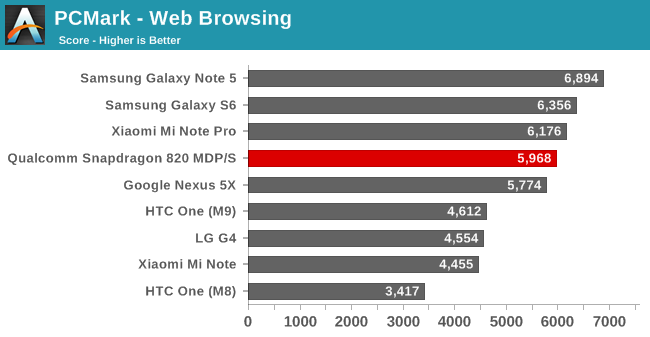
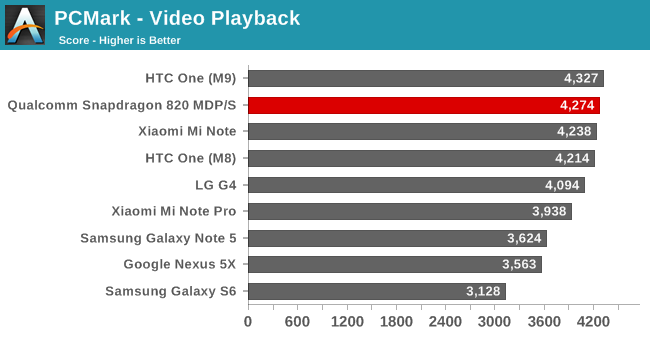
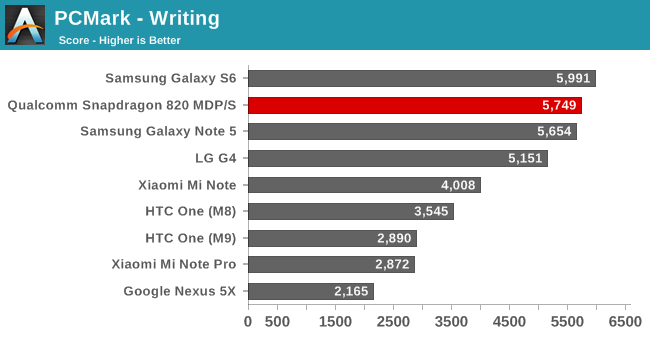
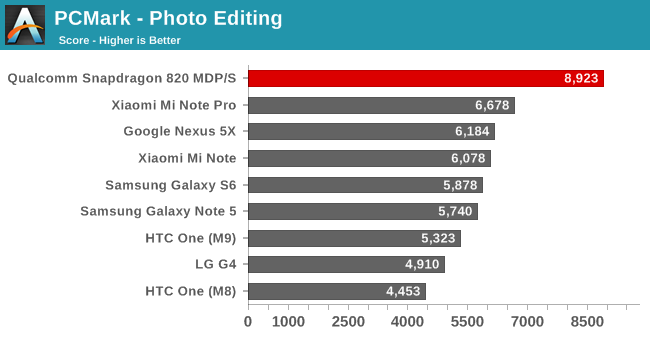
Our final system benchmark, PCMark, once again puts the MDP/S in a good light overall, while the individual sub-tests are more widely varied. Likely owing to the same optimization issues that dogged Chrome performance, web browsing performance trails the A57 devices. Meanwhile video playback closely trails the Snapdragon 810 powered HTC One M9, and writing performance won’t quite surpass the Galaxy S6. Where the 820 MDP/S makes up for it is in the photo editing score, which is through the roof. Here Qualcomm’s development device holds a 34% performance lead over the next-fastest device, the 810/A57 based Mi Note Pro.










146 Comments
View All Comments
Rixxos - Friday, December 11, 2015 - link
All in all the preliminary results show some impressive performance gains over the older generation of socs in Android phones. Especially the memory bandwidth and gpu performance seems much better. I don't see the A9 as a direct competitor as it is on a whole different OS and I doubt anyone who ever jumps over to a different OS does this as a result of CPU benchmark scores. I expect the Samsung M1 soc to step it up even a bit more especially in multithreaded benchmarks because of the extra cores. All in all it seems 2016 will finaly again be a decent year for Android phones in terms of high end socs. I just hope all this extra power and efficiency won't go wasted on useless gimmicks such as qhd or 4k screens. (VR apllications aside).bushgreen - Friday, December 11, 2015 - link
Does it use all 4 cores at the same time? 2 of these cores is enough it will not throttle at all. Why would u need 4 cores on a phone even all the macbooks except 15" only have 2 cores. They used a big reference phone so the heat can dissapate.bushgreen - Friday, December 11, 2015 - link
Does it use all 4 cores at the same time?tipoo - Friday, December 11, 2015 - link
In benchmarks it does. The question is how much the governor will do that in real apps.milli - Friday, December 11, 2015 - link
Went ahead and made a comparison to the A9 in Geekbench.http://i.imgur.com/Qq4OHys.png
Mondozai - Saturday, December 12, 2015 - link
Thanks! Useful stuff. So slower in SP, the most important metric. Disappointing bit expected. This is why Google are launching their SoC initiative.Gunbuster - Friday, December 11, 2015 - link
It will be interesting to see if Microsoft goes with an 820 for their next phone and continues to be hamstrung by a single supplier option or if they get off their duff and compile Win 10 Mobile for X86 Atom in the fabled "Surface Phone"SpartyOn - Friday, December 11, 2015 - link
Based on the rumors I've been reading, sounds like the Atom X3 Surface Phone has been canceled in favor of a newer, upcoming Intel x86 mobile CPU architecture. Personally, I'm still hanging on to my old Lumia 822 until the Surface Phone is released, and I can't be happier if this rumor turns out to be true.The X3 is old school architecture compared to what 2016 ARM CPU's will have, plus it would have totally sucked on the graphics side of things. Braswell arch ups the graphics capabilities, but is lacking on the CPU side, especially in single threaded. I'm hoping for a brand new, previously unannounced Intel x86 for 2016 that will make it into the Surface Phone.
Microsoft can't afford to cripple their premium line with subpar performance, even if does fill the niche of running x86 apps.
Mondozai - Saturday, December 12, 2015 - link
Still using L1520 and amazingly happy. WP is so goddamn fluid. Personally not missing any apps.ws3 - Saturday, December 12, 2015 - link
I know something me who still uses an original iPhone from 2007. Like your outdated Lumina, it also is very fluid and lacks apps.